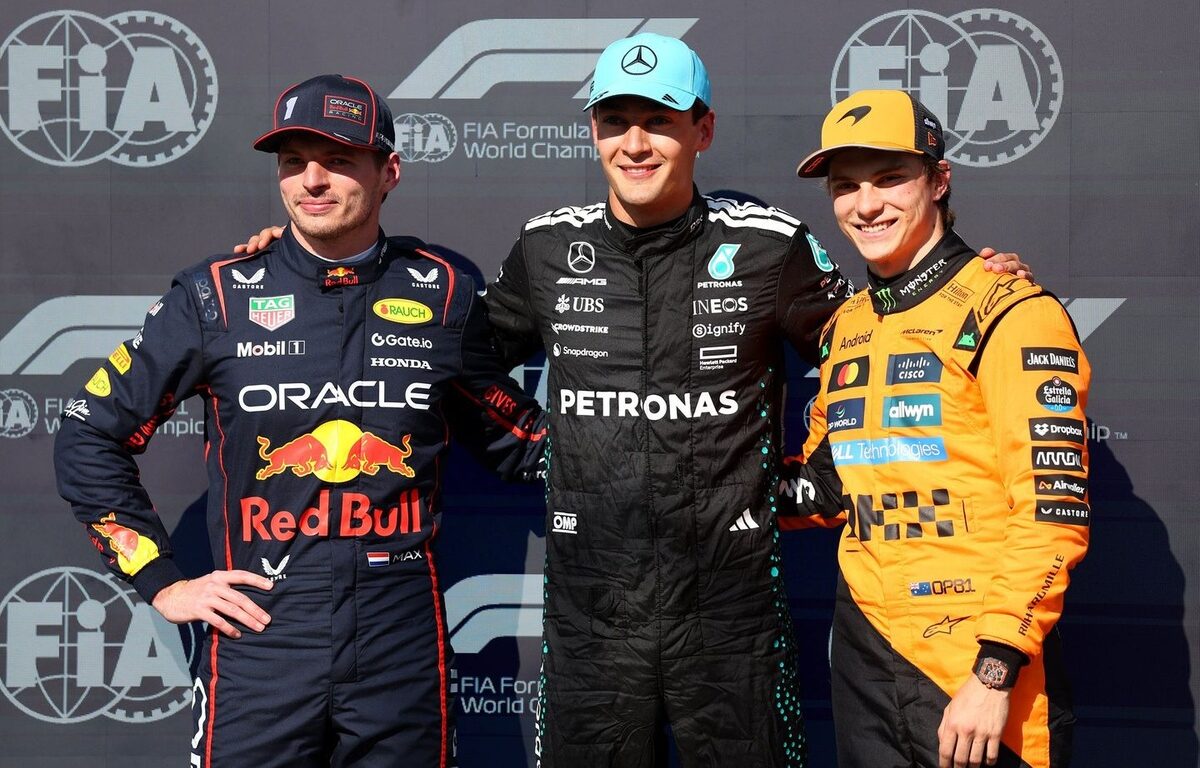
George Russell and Max Verstappen sharing the front row for the Canadian Grand Prix feels familiar. Last year, the sharp end of the grid was exactly the same, with the Mercedes driver on pole and Verstappen alongside him. A key difference with the 2024 edition, however, is that both drivers didn’t clock identical lap times this time. Russell was over a tenth and a half quicker than Verstappen, with the GPS data revealing some interesting insights.
Qualifying laps compared: Russell versus Verstappen
Up to Turn 8, both drivers’ lap times were nearly identical again, with Verstappen even slightly ahead. But Russell braked later going into the chicane, gaining a full tenth heading into the Turn 10 hairpin. There too, the Mercedes driver braked a little later than Verstappen, who took a slightly different line through the hairpin compared to most of his rivals. This gave Verstappen a slightly better exit, allowing him to reduce the gap back to about a tenth of a second by the end of the long straight. It also emphasises that the Red Bull car is aerodynamically a bit more efficient than the Mercedes W15. However, Russell hit the brakes later again for the final chicane – perhaps related to the braking issues that Verstappen experienced earlier in the weekend – ultimately crossing the line 0.160 seconds ahead.
George Russell Max Verstappen GPS-data kwalificatie Canada

George Russell Max Verstappen GPS-data kwalificatie Canada

Even more interesting is what Friday’s long-run data tells us about the race at the magnificent Circuit Gilles Villeneuve. The first variable is, of course, that both drivers get through the opening lap in one piece. Verstappen’s penalty points remain a hot topic for that, although the Dutchman refused to comment on that himself after qualifying: “I don’t need to hear it again. It’s really pissing me off. I mean, you were speaking about it on Thursday and it’s such a waste of time. It’s very childish. So, that’s why I also don’t want to say too much because it’s really annoying, this world that we live in.”
Russell joked right after getting out of his car that he has ‘some more penalty points to play with’, but added during the press conference – just like Oscar Piastri – that it won’t necessarily change his approach. However, the Brit was quick to make clear he won’t give up the lead without a fight: “We’re both fighting for the win here, and neither of us are really in a championship battle. I haven’t had a win this year, so I want to get one on the board. Time will tell.”
Long Runs: Small margins between McLaren, Verstappen, and Mercedes
Assuming both Russell and Verstappen survive the opening laps cleanly, the race could become a straight fight based on race pace in the dry. From that perspective, Sunday’s grid is also a fascinating one. Lando Norris showed the best long-run pace on Friday, but after a disappointing qualifying, he’ll be starting from seventh on the grid and has work to do – also compared to his team-mate and main championship rival.
Piastri was slightly quicker in the long runs than the drivers ahead of him on the grid as well, although the margins were modest compared to most other Fridays this year. Verstappen, for example, lost less than two-tenths per lap compared to the McLaren pair. Also worth noting: his tyre degradation – meaning the time lost per lap due to tyre wear – was lower than both McLarens on Friday. That could prove important over a full stint, as was the case in Imola.
Behind Verstappen, the long-run data from PACETEQ also showed tight margins. The reigning world champion lost an average of 0.18 seconds per lap to Norris, while Russell lost 0.24 seconds in his Mercedes. This means that the fastest cars (both McLarens) are a bit further down the grid, but also that Friday’s lap times were closer than we’ve typically seen in 2025.
Max Verstappen, Red Bull Racing

Having said that, Russell did point out one important variable for the race: the weather, especially the temperatures. “We had good race pace on Friday, but it depends on the temperature. In practice, it was five degrees cooler than it was today, and the car was easily in its sweet spot. Now, it can easily go the other way tomorrow in the race. If the sun comes out – it’s a 2pm race, it was a 4pm qualifying today – that makes quite a bit of difference.”
The Mercedes driver added: “It’s not going to be an easy race and, of course, I’ve got some really quick guys around me. We don’t know if it’s going to be a one-stop or a two-stop, so it won’t be straightforward.”
Read Also:
‘Pissed off’ Max Verstappen is done talking about F1 penalty points
This is the starting grid for the 2025 F1 Canadian GP
That last point is interesting. According to Pirelli’s Mario Isola, a two-stop strategy should be about 10 seconds quicker, but a one-stopper could still be viable depending on how the race unfolds. The latter depends heavily on how crucial track position proves to be in Montreal, which could make strategy an important variable.
In the midfield, Alex Albon and Sauber stood out on Friday with strong long-run performances. The Hinwil-based team surprised during the Spanish Grand Prix as well, which ultimately led to a fifth-place finish for Nico Hulkenberg. Yuki Tsunoda’s long-run times didn’t inspire much confidence for a comeback race, although it should be noted he was running an older spec on Friday. Red Bull didn’t want to risk losing new parts in a crash once again, so Tsunoda only received the upgrade on Saturday. The Japanese driver called it “free lap time,” though that doesn’t take into account his heavy grid drop, meaning the Canadian Grand Prix is shaping up to be another uphill battle for him.
To read more Motorsport.com articles visit our website.


